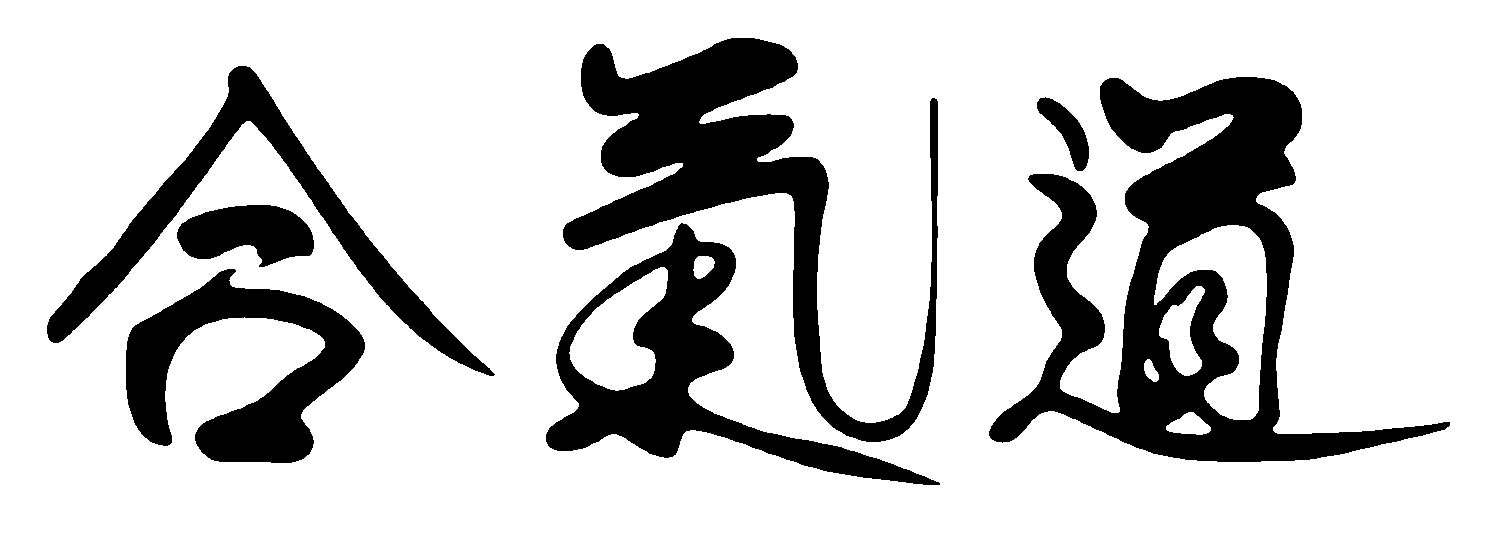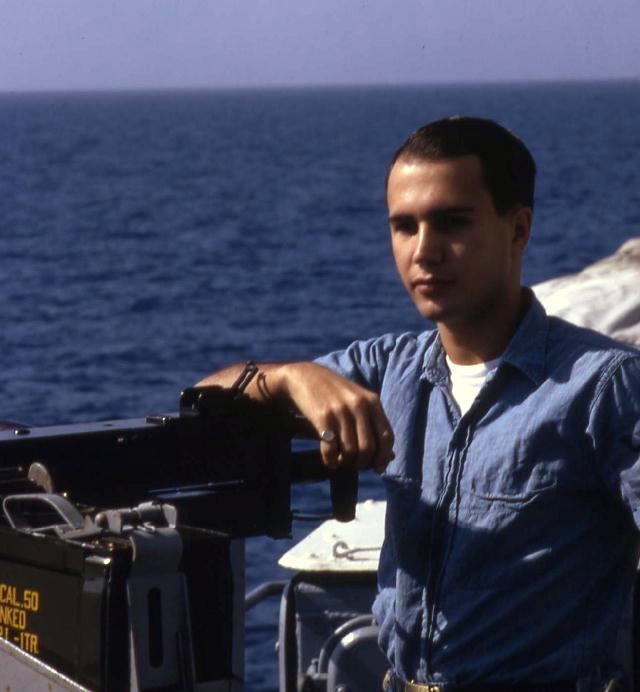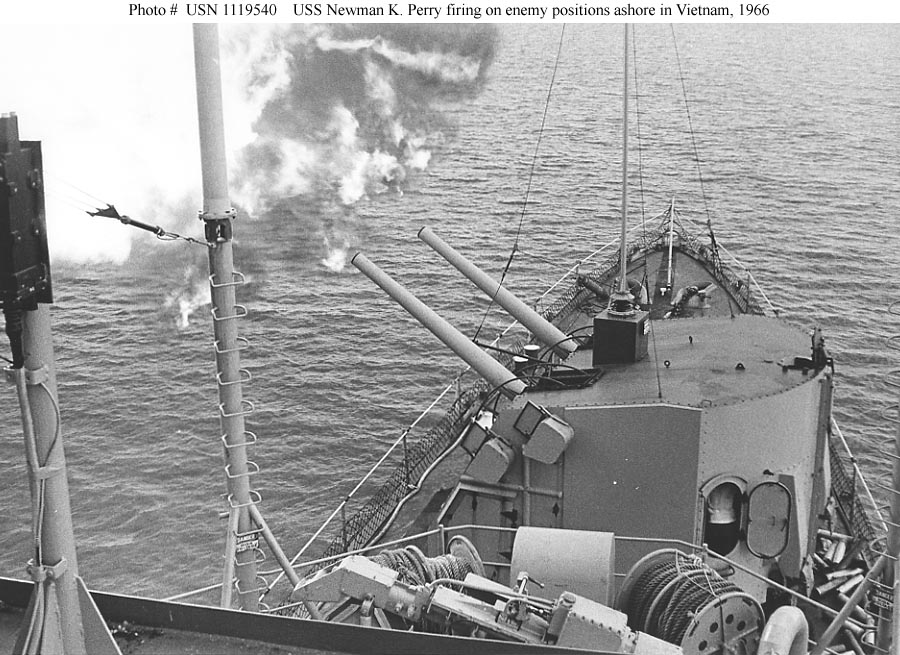Iwama Aikido
Traditional Aikido: As Taught in Iwama, Japan



BACKGROUND
I was a fire control technician on the destroyer USS Newman K. Perry DD-883 during
our West Pac Cruise and tour of duty in Vietnam in 1966-1967. My job was to maintain
and operate the MK 37 fire control system which aimed our two 5" 38 twin gun mounts.
- David G. Alexander - FTG2, USN
THE MEKONG DELTA
We provided gunfire support for our soldiers and marines on the ground. When we first
arrived we prepared for biological and nuclear warfare. After a few days it became
clear that we were not going to be subjected to any such attacks. It was very hot,
and some of the guys started running around in skivvy shorts and shower shoes. On
one day we fired a mission out of mount 52 and simultaneously showed a movie on the
mess decks behind mount 51.
We started out with a full crew in the fire control plotting room. However, after
a few missions Master Chief Morris and I realized that the fire control problem was
very simple and utilized only a small portion of the capability of our system.
All of the missions were indirect fire at stationary targets, with zero elevation
and negligible wind. Due to the shallow water off the Delta, we had to fire over
the horizon at ranges of 12,000 to 18,000 yards to avoid running aground. We got
target locations from spotters on the ground or in little "bird dog" O1 airplanes,
and someone in the bridge or the combat information center (CIC) crunched the numbers
and gave us coordinates relative to our ship.

Chief Morris and I excused everyone else from further presence in the plotting room and took turns operating the entire fire control system single-handedly. The job included operating all of the stations on the MK 1A mechanical analog computer that aimed the guns, and handling all of the sound powered phone communications with the bridge and the gun mounts.

After a while it got so easy it was almost boring. Some of the night missions got kind of busy, firing high explosive rounds out of one mount and star shells out of the other, and juggling the coordinates and spots (offsets from the base coordinates) for both of them. But no big deal.
THE VISITOR
For some reason a south Vietnamese gunners mate was assigned to our ship, I guess
to see how our system operated. As leading petty officer of the gunnery division,
I was assigned to be his escort.
I don't remember his name or the few words in Vietnamese that he taught me, but he
was a very nice guy and we enjoyed some pleasant chats together.
He was down in plot with me during one fire mission. Every time I pulled the trigger
and the guns went bang, he got a very grim expression on his face. I didn't know
why, but after a while he told me his story.
His father was the chief of a small village, and was opposed to the Viet Cong. One
day the VC came to the village, assembled the villagers, tied his father to a tree,
and tortured him to death in a horrible way in front of the villagers including his
son. It made perfect sense now. He felt like he was getting revenge.
I was under strict orders to not let him touch anything, but if we were alone during
the next fire mission I was going to let him pull the trigger. But it didn't happen;
he was rotated off the ship before we got a chance.
PANIC
We spent 26 consecutive days on the gun line off the Delta providing continuous gunfire
support. If we weren't shooting, we were sending a highline to a support ship to
get food, fuel or ammunition. These were all-hands operations, and we were all seriously
deprived of sleep.
My bunk was sandwiched between mount 52, the sonar transducer, the propellers and
an air duct. Needless to say, when the Chief was shooting a mission out of mount
52, it got pretty noisy down there. But on the few occasions that I did get a chance
to sleep, I went right under without hearing a thing.
One night I was in plot and got a call for fire. It started out like any other mission.
I got coordinates and spots from the bridge, dialed them into the computer, and sent
the rounds out.
But something happened. Just as I squeezed the trigger, I realized that I had put
in a spot backwards. Panic hit; I thought "what have I done? did I just drop high
explosives on our own people?".
I could not say anything and hope that nothing bad would happen and nobody would notice.
But then I would go through the rest of my life not knowing. I did one of the hardest
things I ever did in my life and called up the bridge and told them what I did.
The next 30 seconds seemed like forever. Then the bridge got back to me and said
that it was an H+I (Harassment and Interdiction) mission and it didn't matter. The
whole area was Viet Cong. We were just firing at random locations in the jungle to
ruin Charlie's night.
It was a huge relief, and as scary as it was I am glad I did the right thing.
THE HELICOPTER
We had a little helicopter flight deck on the rear of our ship. It was designed for
a DASH (Drone Anti-Submarine Helicopter). We never had one of those, but there were
a lot of our full size helicopters flying around the area. It was popular for them
to land on our flight deck and the pilot go up to the bridge and drink coffee with
the captain.
One day we had one on our flight deck and got a call for fire. It turned out that
the right gun of mount 52 was almost in the stops and aimed close to the helicopter.
The mount captain in 52 called up and told me about the situation and asked if we
really wanted to fire. I relayed this information to the bridge and waited for a
response.
The guy on the sound powered phones on the bridge had his key open and I could hear
everything they were saying. At one point the pilot said "Go ahead and shoot, you
can't hurt it". The bridge then ordered me to fire.
From what I heard, the first salvo blew both doors off the helicopter and did substantial
damage to other parts. We spun the ship around to get the gun away from the helicopter
and finished shooting the mission.
We had to steam all the way to Vung Tau to get the helicopter off the ship. For
some reason I remember a huge Sikorsky Sky Crane helicopter lifting the thing off
and taking it away, but another shipmate says that they stripped it and it flew off
under it's own power. Whichever, it's been 50 years, and at this point in my life
there are entire decades that I don't remember anything about.
And that's how I messed up one of our own helicopters in Vietnam. Although I pulled
the trigger, I tried to warn them and they didn't listen.
PHU QUOC ISLAND
Phu Quoc Island is located in the Gulf of Siam just off the border with Cambodia.
We got sent there for a 5 day joint operation with a Special Forces (Green Beret)
unit. They planned everything and handled the operations on the ground. We provided
gunfire support for them.
The first few days were pretty routine, just like the Mekong Delta. But the last
day got crazy (or so it seemed).
We had an aerial spotter who gave us coordinates and spots. I put them in and sent
the rounds out. But then the bridge gave me a huge spot. I asked them to confirm,
which they did, and it was real. After that I got wildly large spots in all different
directions.
Chief Morris was up on deck watching the show. He came running down to plot and
yelled "what the hell are you doing, you're hitting all over the place". So I rattled
off the last 5 spots I got. He was as surprised as I was, but he said "OK, carry
on".
After a while there were no more spots. My next order was "51, 52, two guns, rapid
continuous fire, fire for effect". I didn't count how many rounds we sent out, but
there must have been at least a hundred aimed at the same coordinates. I bet the
loaders in the gun mounts got the workout of their lives.
None of us knew what was happening on the ground at the time, but we got some information
later. The Special Forces operators had an effective strategy. The spots were to
fire behind the various VC units and drive them into one place in a valley, from which
they could all be taken out by the rapid continuous fire.
They said that the life expectancy of a spotter pilot over there was about 2 weeks.
I don't know if that is true, but it seemed like our pilot wanted to live it up while
he could. After the last mission he departed after flying what seemed to be a few
feet over our radar mast, inverted and waving his wings. I sure hope he made it back
home alive.
SAYONARA
Us enlisted men maintained and operated all the equipment, and very rarely saw the
officers. We wondered what they actually did besides sitting around their wardroom
and being waited on by Filipino stewards all day. Maybe they actually did do something
constructive, but I don't know what it was.
In December of 1965 we crossed the North Atlantic coming back from our Mediterranean
cruise. It was icy cold and there was freezing spray blowing onto the decks.
As usual, the chow line was outside on the main deck. One day the officers apparently
had a flash of humanity and allowed us to have the chow line in the midship passageway
out of the elements.
This lasted one day. Then, the officers apparently decided that they had to keep
the midship passageway clear in case one of them had to use it to get somewhere.
So, back on the freezing main deck for the crew.
After treating us like this they wondered why nobody wanted to ship over. We took
solace in saying "I've been to hacking school, I can hack it", and counting the days
until we could get out (e.g. 653 and a wakeup). Short-timer jokes abounded, like
"I'm so short I can walk under a door without opening it".
There were good times and bad. We got to go all the way around the world and see
a lot of countries. We had to put up with a lot, but all in all it was one hell of
a ride.
Best regards and wishes to all my shipmates of the USS Newman K. Perry.